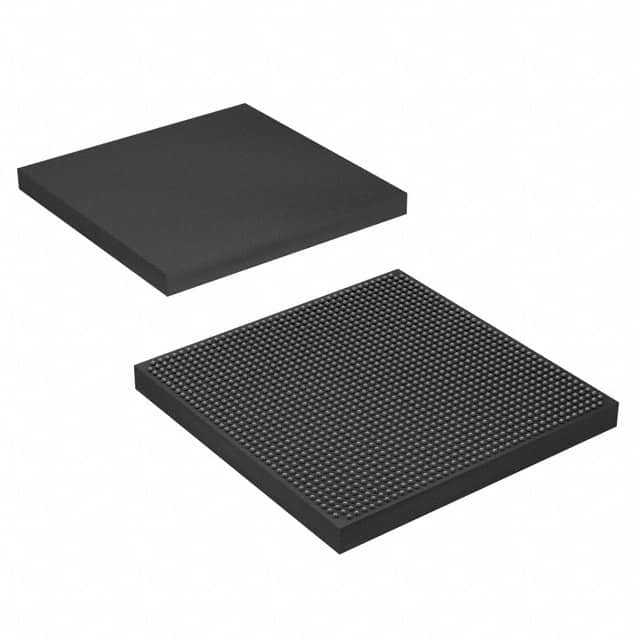5SGXMA3K3F40C3N
Product Overview
Category
The 5SGXMA3K3F40C3N belongs to the category of Field Programmable Gate Arrays (FPGAs).
Use
This FPGA is designed for high-performance applications that require complex digital logic circuits. It provides a flexible and reconfigurable hardware platform that can be programmed to perform various tasks.
Characteristics
- High-performance FPGA with advanced features
- Large capacity for complex designs
- Low power consumption
- High-speed data processing capabilities
- Flexible and reconfigurable architecture
Package
The 5SGXMA3K3F40C3N comes in a compact package suitable for integration into electronic systems. The package ensures proper protection and thermal management for the FPGA.
Essence
The essence of this FPGA lies in its ability to provide a customizable hardware solution for demanding applications. It allows designers to implement complex algorithms and digital logic circuits efficiently.
Packaging/Quantity
The 5SGXMA3K3F40C3N is typically sold individually or in small quantities, depending on the requirements of the customer. The packaging ensures safe transportation and storage of the FPGA.
Specifications
- Logic Elements: 358,400
- Embedded Memory: 10,272 Kbits
- DSP Blocks: 2,073
- Maximum User I/Os: 1,040
- Transceivers: 48
- Operating Voltage: 1.2V
- Operating Temperature Range: -40°C to 100°C
- Package Type: F40
- Package Pins: 1517
Detailed Pin Configuration
The detailed pin configuration of the 5SGXMA3K3F40C3N FPGA can be found in the manufacturer's datasheet. It provides information about each pin's functionality, voltage levels, and recommended connections.
Functional Features
- High-speed data processing capabilities
- Support for various communication protocols
- On-chip memory resources for efficient data storage
- Flexible I/O interfaces for easy integration with external devices
- Reconfigurable architecture for dynamic hardware modifications
Advantages and Disadvantages
Advantages
- High-performance FPGA suitable for complex designs
- Low power consumption compared to alternative solutions
- Flexibility and reconfigurability allow for rapid prototyping and design iterations
- Large capacity enables the implementation of advanced algorithms and digital logic circuits
Disadvantages
- Higher cost compared to other programmable logic devices
- Steeper learning curve for inexperienced users
- Limited availability of technical support for specific design challenges
Working Principles
The 5SGXMA3K3F40C3N FPGA operates based on the principles of configurable logic. It consists of a matrix of programmable logic elements interconnected through configurable routing resources. The user can program the FPGA to define the desired functionality by configuring the interconnections and logic elements.
Detailed Application Field Plans
The 5SGXMA3K3F40C3N FPGA finds applications in various fields, including:
- Telecommunications: Used in high-speed data transmission systems, network routers, and switches.
- Aerospace and Defense: Employed in radar systems, avionics, and secure communication systems.
- Industrial Automation: Utilized in control systems, robotics, and machine vision applications.
- Medical Devices: Integrated into medical imaging equipment, patient monitoring systems, and diagnostic instruments.
- Research and Development: Used as a flexible platform for developing and testing new algorithms and digital designs.
Detailed and Complete Alternative Models
- 5SGXEA7K2F40C2N: Similar FPGA from the same family with enhanced features and larger capacity.
- 5CGXFC7D6F27C7N: Alternative FPGA from a different family with lower capacity but lower cost.
- XC7A35T-1CPG236C: FPGA from a different manufacturer with comparable features and performance.
These alternative models provide options for different project requirements, allowing designers to choose the most suitable FPGA for their specific needs.
Word count: 550 words
قم بإدراج 10 أسئلة وإجابات شائعة تتعلق بتطبيق 5SGXMA3K3F40C3N في الحلول التقنية
Sure! Here are 10 common questions and answers related to the application of 5SGXMA3K3F40C3N in technical solutions:
Q: What is the 5SGXMA3K3F40C3N FPGA used for? A: The 5SGXMA3K3F40C3N is a Field-Programmable Gate Array (FPGA) that can be used for various applications such as high-performance computing, networking, and signal processing.
Q: What are the key features of the 5SGXMA3K3F40C3N FPGA? A: Some key features include a large number of logic elements, high-speed transceivers, embedded memory blocks, and support for various communication protocols.
Q: Can the 5SGXMA3K3F40C3N FPGA handle high-speed data transmission? A: Yes, the FPGA has high-speed transceivers that can support data rates up to several gigabits per second, making it suitable for applications requiring fast data transmission.
Q: How can I program the 5SGXMA3K3F40C3N FPGA? A: The FPGA can be programmed using hardware description languages (HDLs) such as Verilog or VHDL, along with design software provided by the FPGA manufacturer.
Q: Is the 5SGXMA3K3F40C3N FPGA suitable for real-time signal processing applications? A: Yes, the FPGA's high-performance capabilities and parallel processing architecture make it well-suited for real-time signal processing tasks.
Q: Can the 5SGXMA3K3F40C3N FPGA be used in network infrastructure equipment? A: Absolutely, the FPGA's high-speed transceivers and support for various communication protocols make it ideal for use in network switches, routers, and other networking equipment.
Q: Does the 5SGXMA3K3F40C3N FPGA have built-in memory? A: Yes, the FPGA includes embedded memory blocks that can be used for storing data or implementing memory-intensive algorithms.
Q: Can I interface the 5SGXMA3K3F40C3N FPGA with other components or peripherals? A: Yes, the FPGA supports various interfaces such as PCIe, Ethernet, USB, and DDR3 memory, allowing easy integration with other components or peripherals.
Q: Is the 5SGXMA3K3F40C3N FPGA suitable for high-performance computing applications? A: Absolutely, the FPGA's large number of logic elements and parallel processing capabilities make it well-suited for demanding computational tasks.
Q: Are there any development boards or evaluation kits available for the 5SGXMA3K3F40C3N FPGA? A: Yes, the FPGA manufacturer provides development boards and evaluation kits that allow users to prototype and test their designs using the 5SGXMA3K3F40C3N FPGA.
Please note that the specific details and answers may vary depending on the context and requirements of the technical solution.


